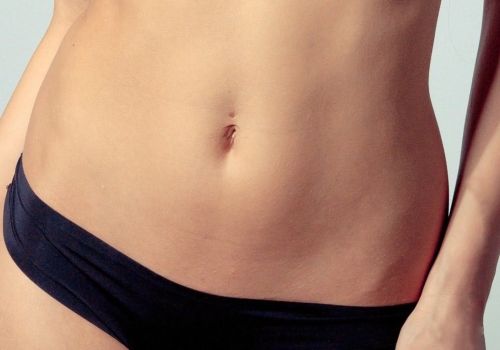Comment atténuer une cicatrice d'abdominoplastie ?
Vous avez réalisé ou envisagez de faire une abdominoplastie ? Cette intervention de chirurgie esthétique permet de retrouver un ventre plat, mais les incisions laissent des cicatrices autour du nombril et au-dessus du pubis. Il est important de prendre soin de votre cicatrice d’abdominoplastie pour lui permettre de s’estomper progressivement. Si son aspect vous gêne, votre chirurgien peut vous proposer différentes solutions, comme enlever votre cicatrice au laser.

Les cicatrices à la suite d’une abdominoplastie
L’abdominoplastie est une intervention de chirurgie esthétique qui vise à retirer l’excès de peau et de graisse au niveau du ventre : la peau abîmée et distendue est retirée et la peau saine retendue. L’intervention s’adresse aussi bien aux hommes qu’aux femmes, à la suite d’une importante perte de poids ou après plusieurs grossesses.
L’abdominoplastie laisse une cicatrice résiduelle plus ou moins importante selon l’ampleur de l’ablation. La cicatrice se situe autour de l’ombilic et au niveau des poils pubiens. Ses dimensions estimées vous sont précisées par le chirurgien avant l’opération. La cicatrice au-dessus du pubis est généralement cachée par les sous-vêtements ou les maillots de bain.
Comment se passe le processus de cicatrisation après une abdominoplastie ?
La cicatrisation d’une plaie opératoire sur l’abdomen suit différentes étapes, chacune d’elles est essentielle pour assurer la formation d’une cicatrice de qualité.
Juste après l’intervention et pendant environ 2 semaines, la cicatrice est plutôt fine. Les cellules de la peau se multiplient et fabriquent de nouveaux composants du derme.
Ensuite, durant 6 mois environ, la cicatrice évolue en profondeur et devient inflammatoire. Rougeur, œdème, sensations douloureuses et démangeaisons font partie des inconforts fréquents.
Après 6 mois et jusqu’à deux ans, la cicatrice va devenir plus discrète (elle blanchit) et elle va s’atténuer au fil du temps, jusqu’à devenir presque invisible.
Les astuces pour une bonne cicatrisation de votre cicatrice d’abdominoplastie
Vous pouvez accompagner le processus de cicatrisation en respectant les recommandations post-opératoires de votre chirurgien. Elles vont limiter les risques d’anomalies et améliorer l’apparence des cicatrices :
- Réalisez les soins indiqués et protégez la plaie avec des pansements. Les pansements en silicone sont particulièrement efficaces pour limiter les démangeaisons.
- Utilisez un vêtement de contention, il permet de diminuer la tension sur les incisions et de réduire l’œdème. Évitez les efforts et attendez deux mois avant de reprendre une activité sportive.
- Pensez à bien hydrater la peau avec une huile végétale ou une crème adaptée conseillée par votre chirurgien.
- Dès que les croûtes ont disparu, massez régulièrement (deux fois par jour) la cicatrice pour assouplir les tissus, réduire les adhérences et stimuler la microcirculation.
- Protégez la cicatrice du soleil. Évitez toute exposition la première année et utilisez ensuite une crème indice 50 minimum.
- Évitez les variations de poids, elles peuvent modifier l’aspect de votre cicatrice abdominale.
Les problèmes de cicatrisation et les cicatrices disgracieuses
Certains patients sont plus sujets aux risques de cicatrisation difficile, cela peut être lié à leur phototype, au fait qu’ils sont fumeurs ou bien à une anomalie génétique. Des complications peuvent survenir pendant le processus de cicatrisation et provoquer une cicatrice d’aspect inesthétique. Certaines cicatrices peuvent avoir un relief bombé, une largeur augmentée, un aspect rougeâtre ou brunâtre et occasionner des démangeaisons ou des douleurs.
Quels sont les traitements pour atténuer une cicatrice ?
Lorsqu’une cicatrice est trop proéminente et devient source de complexes pour le patient, il est possible d’intervenir pour la réduire. Différentes techniques peuvent être mises en œuvre, selon qu’il s’agisse d’une cicatrice récente ou plus ancienne.
Une révision chirurgicale peut être effectuée six mois ou plus après l’intervention dans le cas où la cicatrice est trop longue et trop large. Cela implique l’ablation du tissu cicatriciel puis une suture des bords de la peau et par conséquent un nouveau processus de cicatrisation.
Si la cicatrice est plus ancienne, il faut se tourner vers un traitement au laser. Le laser CO2 fractionné est une solution qui permet d’obtenir de bons résultats pour relisser la peau et atténuer les cicatrices. Les séances ne durent pas plus d’une heure et doivent être espacées de 4 à 6 semaines. Il existe des contre-indications à ce traitement au laser, elles seront abordées lors de la consultation avec le docteur.
Prenez conseil auprès des médecins et chirurgiens esthétiques de la Clinique du Lac si vous souhaitez vous débarrasser de vos cicatrices à la suite d’une abdominoplastie ou d’une autre opération.
